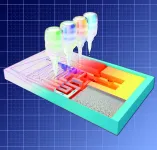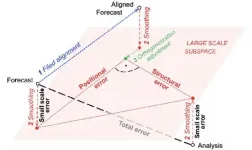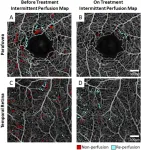3D printing lays the foundation for a new range of diagnostic tests
2021-05-10
(Press-News.org) Researchers at KU Leuven (Belgium) have developed a 3D printing technique that extends the possibilities of lateral flow testing. These tests are widespread in the form of the classic pregnancy test and the COVID-19 self-tests. With the new printing technique, advanced diagnostic tests can be produced that are quick, cheap, and easy to use.
The COVID-19 pandemic has made everyone aware of the importance of rapid diagnosis. The sale of self-tests in pharmacies has been permitted in Belgium since the end of March. This self-test is a so-called lateral flow test. Using a wiper, a sample is taken through the nose. Next, it is dissolved in a solvent, and applied to the test kit. Absorbent material in the kit moves the sample downstream and brings it in contact with an antibody. If virus is present, a coloured line appears. The advantage of these tests is that they are cheap and do not require any specialised appliances.
Lateral flow tests are useful for simple tests that result in a yes-no answer, but not for tests that require a multi-step protocol. That is why bioengineers at KU Leuven set out to develop a new type of lateral flow test with more capabilities.
Precise prints
Using a 3D printer, the researchers fabricated a 3D version of a lateral flow test. The basis is a small block of porous polymer, in which 'inks' with specific properties are printed at precise locations. In this way, a network of channels and small 'locks' is printed that let the flow through or block it where and when necessary, without the need for moving parts. During the test, the sample is automatically guided through the different test steps. That way, even complex protocols can be followed.
The researchers evaluated their technique reproducing an ELISA test (Enzyme-Linked Immunosorbent Assay), which is used to detect immunoglobulin E (IgE). Ig E is measured to diagnose allergies. In the lab, this test requires several steps, with different rinses and a change in acidity. The research team was able to run this entire protocol using a printed test kit the size of a thick credit card.
Complexity is not a cost
"The great thing about 3D printing is that you can quickly adapt a test's design to accommodate another protocol, for example, to detect a cancer biomarker. For the 3D printer it does not matter how complex the network of channels is", says Dr. Cesar Parra. The 3D printing technique is also affordable and scalable. "In our lab, producing the Ig E prototype test costs about $ 1.50, but if we can scale it up, it would be less than $ 1," says Dr. Parra. The technique not only offers opportunities for cheaper and faster diagnosis in developed countries, but also in countries where the medical infrastructure is less accessible and where there is a strong need for affordable diagnostic tests.
The research group is currently designing its own 3D printer, which will be more flexible than the commercial model used in the current study. "An optimised printer is kind of like a mobile mini factory which can quickly produce diagnostics. You could then create different types of tests by simply loading a different design file and ink. We want to continue our research on diagnostic challenges and applications with the help of partners", concludes innovation manager Bart van Duffel.
Video: https://youtu.be/qRVa7X_LnV4
INFORMATION:
[Attachments] See images for this press release:

ELSE PRESS RELEASES FROM THIS DATE:
2021-05-10
Analysis of The Autopsy, Toxicological, and Psychiatric Reports of Portugal's First Major Forensic Case: Part III
https://doi.org/10.1080/20961790.2021.1898079
Announcing a new article publication for Forensic Sciences Research journal. In this review article the author Ricardo Jorge Dinis-Oliveira of the University Institute of Health Sciences (IUCS)-CESPU, Gandra, Portugal continues a three-part investigation of the "Crime of Flores Street" one of the most famous cases of poisoning which occurred in Portugal in the late 19th century. The case demonstrated the weaknesses of the Portuguese medicolegal system and attests to the importance of toxicological analysis. The first article ...
2021-05-10
Most people who are infected with SARS-CoV-2 develop no or only mild symptoms. However, some patients suffer severe life-threatening cases of COVID-19 and require intensive medical care and a ventilator to help them breathe. Many of these patients eventually succumb to the disease or suffer significant long-term health consequences. To identify and treat these patients at an early stage, a kind of "measuring stick" is needed - predictive biomarkers that can recognize those who are at risk of developing severe COVID-19.
First biomarker to predict severity of disease
A team led by Professor Burkhard Becher at the Institute of Experimental Immunology at the University of Zurich, working with researchers from Tübingen, Toulouse and Nantes, has now discovered such ...
2021-05-10
Due to the chaotic nature of the atmosphere, weather forecasts, even with ever improving numerical weather prediction models, eventually lose all skill. Meteorologists have a strong desire to better understand this process as they try to trace forecast error back to observational gaps and to provide a means for improvement.
Root mean square error (rms, or its square, the variance distance) is often used to measure differences between simulated and observed fields. In this case, scientists measured the distance between a model forecast field within its grid and the verifying analysis field ...
2021-05-10
A pioneering study by UCL scientists has discovered the presence of a harmful inflammatory protein in patients with symptomatic tuberculosis (TB).
Researchers say, by targeting the IL-17 cytokine, a component produced naturally by the immune system in response to infection, excessive and damaging lung inflammation caused by TB may be significantly reduced to help speed up patient recovery.
TB is an infection caused by the bacterium Mycobacterium tuberculosis and is the leading cause of death from infections worldwide. The World Health Organisation estimates that 1.4 million people died of TB disease worldwide in 2019.
Explaining the experimental study, lead author Dr Gabriele Pollara (UCL Division of Infection & Immunity), ...
2021-05-10
In a time of a global crisis such as the ongoing COVID-19 pandemic, it is easy to note how people move through different phases to buckle up for such unprecedented and arduous times.
In the very beginning of the pandemic last year, we observed "an epidemic of fear", where it was all about the calamitous nature of a totally unknown virus and its worrying contagiousness and mortality rate. A few months later, with lockdown and restrictions already in place across the world, the fear was replaced by "an epidemic of explanations", where people even in their naivety, started to seek a sense of comfort by ...
2021-05-10
Climate change, a pandemic or the coordinated activity of neurons in the brain: In all of these examples, a transition takes place at a certain point from the base state to a new state. Researchers at the Technical University of Munich (TUM) have discovered a universal mathematical structure at these so-called tipping points. It creates the basis for a better understanding of the behavior of networked systems.
It is an essential question for scientists in every field: How can we predict and influence changes in a networked system? "In biology, one example is the modelling of coordinated neuron activity," says Christian Kühn, professor of multiscale and stochastic dynamics ...
2021-05-10
Can expert commissions develop solutions for controversial issues that will enjoy broad democratic support? A team of researchers from the Institute for Advanced Sustainability Studies (IASS) has analysed the work of Germany's "Coal Exit Commission" using a set of new criteria. While the authors view positively the Commission's success in reaching a compromise, they criticise its failure to deliver an outcome that promotes the common good, particularly with respect to the high cost of the coal exit and its unambitious contribution towards Germany's climate goals, as well as the lack of public participation.
On 29 April 2021, Germany's Federal Constitutional Court ruled that the provisions of the Climate Protection Act (2019) are incompatible ...
2021-05-10
Only one in three fertilizations leads to a successful pregnancy. Many embryos fail to progress beyond early development. Cell biologists at the Max Planck Institute (MPI) for Biophysical Chemistry in Göttingen (Germany), together with researchers at the Institute of Farm Animal Genetics in Mariensee and other international colleagues, have now developed a new model system for studying early embryonic development. With the help of this system, they discovered that errors often occur when the genetic material from each parent combines immediately after fertilization. This is due to a remarkably inefficient process.
Human somatic cells typically have 46 chromosomes, which together carry ...
2021-05-10
Ophthalmologists at New York Eye and Ear Infirmary of Mount Sinai have created a new technique to evaluate patients with sickle cell retinopathy and assess the disease before it progresses and leads to permanent vision loss.
Using optical coherence tomography (OCT) angiography--an advanced imaging system that captures the motion of red blood cells in blood vessels non-invasively--the researchers discovered that sequential imaging of affected retinal blood flow in sickle cell patients can help assess how the disease is progressing and how effective their treatment is for reducing focal vascular strokes. Their study was published ...
2021-05-10
Porcupines are frequently traded across Asia, and Indonesia, home to five species, is no exception. They are targeted for a number of reasons: their meat as an alternative source of protein, their bezoars consumed as traditional medicine, and their quills used as talismans and for decorative purposes.
A new study examining seizure data of porcupines, their parts and derivatives in Indonesia found a total of 39 incidents from January 2013 to June 2020 involving an estimated 452 porcupines. The research was published in the open-access, peer-reviewed journal Nature Conservation.
There are no harvest quotas for any porcupine species in Indonesia, which makes all hunting and trade in porcupines illegal. Of the five species found in the country, only the Sunda porcupine (Hystrix javanica) ...
LAST 30 PRESS RELEASES:
[Press-News.org] 3D printing lays the foundation for a new range of diagnostic tests





